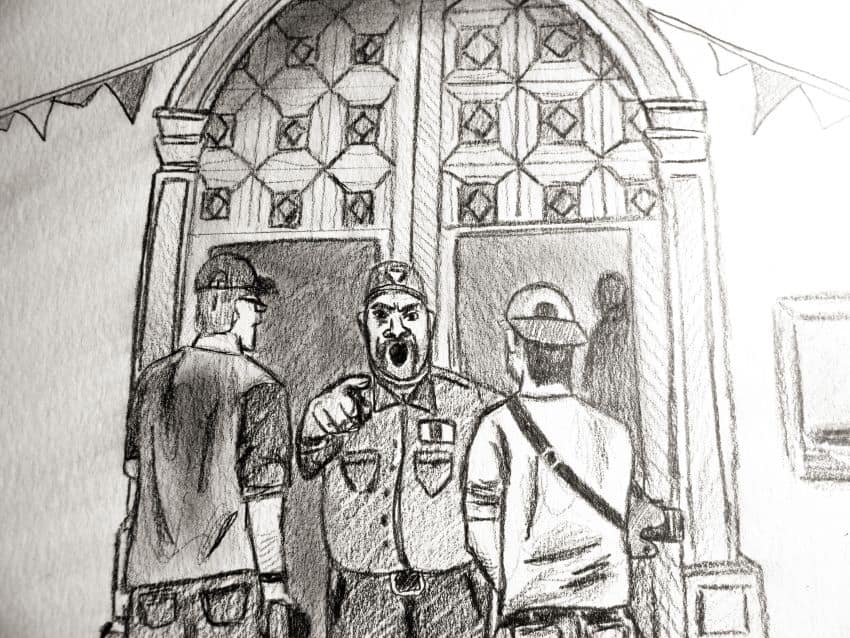It was in Tlalixtac, a village about 20 miles outside of Oaxaca, on Good Friday when I heard the words that no one ever wants to hear anywhere, but especially in Mexico.
You are going to jail.
I was in Tlalixtac to photograph Semana Santa. I was told it’s an interesting place, especially on Good Friday, when they reenact Christ’s crucifixion. Earlier that week, I’d met Dylan, a young Mexican-American photographer, and we decided to photograph together. It was really good for me because at the time I had only a rudimentary grasp of Spanish and he was bilingual. Plus, he taught me some slang and curses, things that always come in handy.
We’d decided to visit Tlalixtac a few days before Good Friday so we could get to know people and get permission to photograph. We went to the local church and talked to the priest and a bunch of people, and everyone said it was OK to take pictures. We started shooting on that first day and returned every day, getting more comfortable.
What we neglected to do, however, was talk to the local authorities.
We were photographing in the church on Good Friday when a local official came up and told us to leave the church. If we didn’t, we’d go to jail. We stepped outside with him, Dylan explaining why we were there and that we had talked to people and the priest and were told it was OK to photograph.
“I do not care,” he said. “If you photograph again, you will go to jail.”
Confused, we went to talk to the priest, and he assured us it was OK to photograph. We’d barely stepped back inside the church when the same official hurried toward us — angrier now.
“Get out of the church,” he said. “And if you photograph in here again, you are going to jail.”
Dylan told him we’d spoken with the priest, but the official replied that the priest wasn’t the one in charge; he was. We asked if it would be OK to photograph outside the church, and he said that would be fine. But first, we headed back to talk with the priest again, Dylan explaining in more detail what we’d been told. Again, he told us to photograph in the church if we wanted to. Slightly confused, we went back to the church but stayed outside. Just as we started photographing, who shows up but our favorite local official.
“OK. That is it!” he yelled. “You are going to jail.”

Explaining to him that he’d just told us we could photograph outside did nothing to calm him down. “How much do you want?” Dylan finally asked.
“Señor, I do not want your money,” was the reply. “I am only trying to protect you. Just last week, some people — they looked like you two — were in the church trying to steal some paintings. The people caught them and dragged them out, and we had to step in to save them.”
Yeah, I bet. Somehow, we didn’t end up paying him anything.
Dylan and I decided to tell some of the folks we’d met that we were going to be arrested. He talked with some young guys and got them to promise to break us out of jail. I talked with a woman and got her to promise to cook us meals if we were arrested. Clearly, we were only taking the threats semi-seriously. I certainly didn’t want to spend time in a Mexican jail but if we were going to be arrested he wouldn’t have threatened us three times. He would have done it. Right?
We had no problems the rest of the day with that official.
The reenactment was pretty intense. They don’t actually nail anyone to the cross, but the young man portraying Christ was whipped so hard as he carried a large cross through the streets that large red welts were raised on his back. The most moving moment was called La Encuentra, a reenactment of Mary meeting Jesus as he made his way to his crucifixion. Then the young man was tied up on a cross for about 90 minutes.
At the end of the day, we asked the priest how he chose who portrayed Christ. He told us it was the young man who came in first in catechism class. I have to admit that if I were in that class, I would’ve tanked.
As we were leaving, I caught sight of the official who’d threatened to throw us in jail. I walked up to him. “Señor,” I said, “we are leaving. You will not see us again.”
“Please, señor,” he replied, shaking my hand, “please come back and visit us soon.”
Joseph Sorrentino, a writer, photographer and author of the book San Gregorio Atlapulco: Cosmvisiones, is a regular contributor to Mexico News Daily. More examples of his photographs and links to other articles may be found at www.sorrentinophotography.com He currently lives in Chipilo, Puebla.
